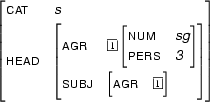13.2 Feature Structures
Feature structures are often written as attribute value matrices. The attribute value matrix expressing that something is singular and 3rd person, i.e. that the feature number has the value singular and the feature person has the value 3, looks as follows:

In this example all feature values are atomic, but they can also be feature structures again. As in this feature structure for instance:

This makes it possible to group features of a common type together.
Another common way of representing feature structures is to use directed graphs. In this case, values (no matter whether atomic or not) are represented as nodes in the graph, and features as edge labels. Here is an example. The attribute value matrix

can also be represented by the following directed graph.

Paths in this graph correspond to sequences of features that lead through the feature structure to some value. The path carrying the labels  and
and  corresponds to the sequence of features
corresponds to the sequence of features  and leads to the value
and leads to the value  .
.
The graph that we have just looked at had a tree structure, i.e., there was no node that had more than one incoming edge. This need not always be the case. Look at the following example:

Here, the paths  and
and  both lead to the same node, i.e., they lead to the same value and share that value. This property of feature structures that several features can share one value is called reentrancy. It is one of the reasons why feature structures are so useful for computational linguistics.
both lead to the same node, i.e., they lead to the same value and share that value. This property of feature structures that several features can share one value is called reentrancy. It is one of the reasons why feature structures are so useful for computational linguistics.
In attribute value matrices, reentrancy is is commonly expressed by coindexing the values which are shared. Written in the matrix notation the graph from above looks as follows. The boxed 1 indicates that the two features sequences leading to it share one value.
